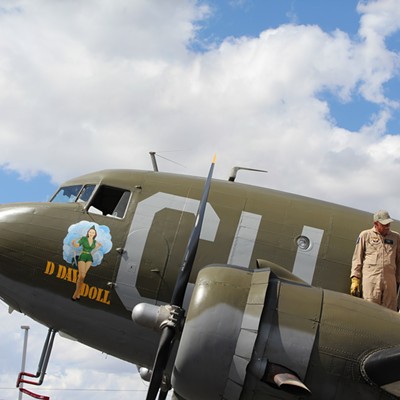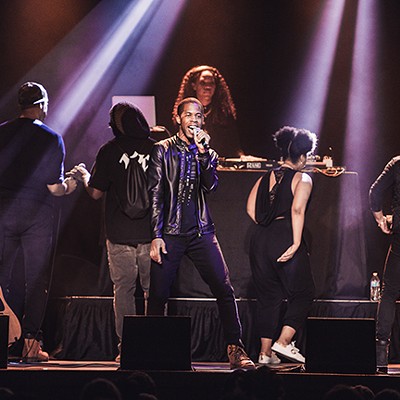"I walked back out on the fo'c'sle; sailors were yelling and pointing towards Ford Island. I went up to see what all the confusion was about, and saw ... planes bombing the airstrip over there. I thought I saw the water tower go over--whether true or not, I don't know. Right away, we figured they were Japanese planes, because we could see their red meatballs on the wings. I just headed for my battle station, one deck above the bridge on the Arizona--on the foremast, the sky control platform. I was the sight setter and director for the portside anti-aircraft guns.
"It seemed like everybody else had the same idea. It wasn't long, general quarters sounded, but some of us were at our battle stations at that time. We started firing ... we could see high-altitude bombers; we couldn't reach them with our anti-aircraft guns. Dive bombers were dive bombing and strafing us, torpedo planes were coming in from Aiea Landing, where the sub base was. ... I had a very good view because I was up so high. ... I saw the Oklahoma capsize and the West Virginia take a hit or two, torpedoes and bombs. I thought I saw two torpedo tracks in the water coming right toward the Arizona, but they tell me the Arizona didn't get hit by a torpedo. How they know, I don't know--or where they went to, I don't know," recalls the Pearl Harbor survivor.
Stratton, plus other U.S. and Japanese veterans of the sneak attack on Oahu, scholars, historians, authors, World War II buffs and filmmakers gathered in Honolulu this week to remember Pearl Harbor. Symposia, war site tours, screenings and banquets commemorates the 60th anniversary of that day that started out like so many others, but ended like no other.
During the gathering, the Discovery Channel hosted its debut of Pearl Harbor: Death of the Arizona. With Oliver Stone-like precision, the documentary seeks to solve--via digital reconstruction of photographic/filmed evidence, underwater archaeology and detective work--the mystery of what really sunk this battleship. Director Erik Nelson says Death's final day of filming--when analysts announced their conclusions--took place in Washington on September 11. Ironically, Nelson and Pearl-based National Park Service historian Daniel Martinez were scheduled aboard the jet that slammed into the Pentagon, but changed flights because of the shoot. "We tried crossing town past the burning Pentagon, and in a very direct sense saw the parallels between 9/11 and December 7," states Nelson, who ended up driving cross-country with Martinez.
The Termite Art Productions documentary, narrated by West Wing First Lady Stockard Channing (voice of the film regularly screened at the USS Arizona Memorial's visitor center), contends that reports that torpedoes hit the Arizona, or that a "bomb went down the smokestack," are "legends." Imperial pilots, Army doctor Eric Haakenson and others photographed and filmed the air raid, and Haakenson's footage of the exploding Arizona is like the Zapruder film of JFK's asassination. Boeing-Autometric analysts, filmmakers and others connect the dots and surmise where a high-altitude bomb struck the Arizona and "ripped through the ship's decks and penetrated a forward magazine, where the ship's gunpowder was stored. It detonated there. The chain of explosive reactions blew through compartment after compartment." Channing adds that this resulted in a plume of smoke blowing out the smokestack--"why witnesses believed a bomb exploded there."
The History Channel also hosted a presentation by myself and my Pearl Harbor in the Movies co-author, Luis Reyes. The latter provided an overview of Pearl pictures; my video/talk focused on celluloid stereotypes in these agitprop flicks. The panel included the premiere of Digital Ranch's Save Our History: U.S.S. Arizona. This History Channel documentary examines exactly what of the world's most famous wreck still exists underwater, and if the estimated half-million gallons of oil still leaking daily from the Arizona present an ecological danger to Pearl Harbor.
Like Death of the Arizona, this documentary looks at the history of the "super dreadnaught" named after the Grand Canyon State, only three years after Arizona was admitted to the union. Up to 75,000 people attended the June 19, 1915 Brooklyn Navy Yard launching of the two football-field-long seagoing city. Esther Ross, daughter of a prominent pioneer citizen of Prescott, christened the Arizona, with bottles of champagne and water--usually considered a bad omen by sailors.
As coal-powered European ships could not service the oil-fuelled Arizona, the battleship with 14-inch guns never saw battle--until an 800-foot fireball destroyed it on December 7, 1941.
Elvis Presley's first concert after leaving the military raised much of the money for the memorial, which opened in 1962.
Shan Sutton, of the University of Arizona's Special Collections library, was a source for Save Our History. The Discovery and History Channel documentaries use some of the same interviewees: Stratton, who describes the burns over 60 percent of his body that still ail him 60 years later; NPS' Martinez and diver Daniel Lenihan; and Gloria Stuart, who co-starred with Jimmy Cagney in 1934's Here Comes the Navy, shot on the Arizona--63 years before starring in a film about another ill-fated ship, Titanic.
December 7's invitation-only ceremony in the memorial structure (with its biblical tree of life motif) above the sunken behemoth, where about 900 sailors are entombed, will be the last Hawaii hurrah for the vanishing Pearl Harbor survivors, and a fitting close for the remembrances of that date that--along with 9/11--still lives in infamy.












